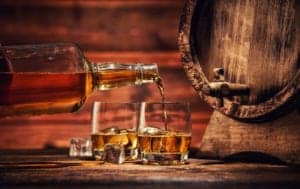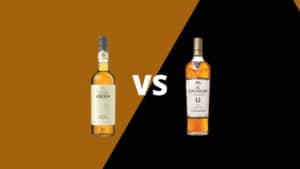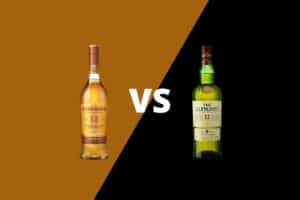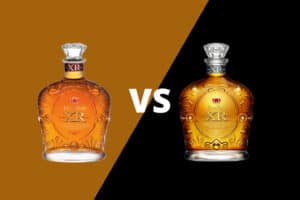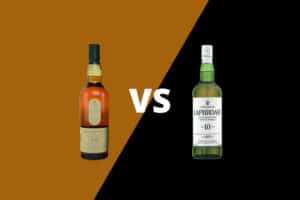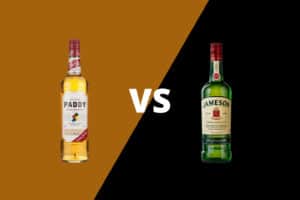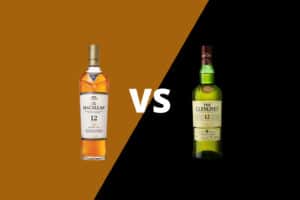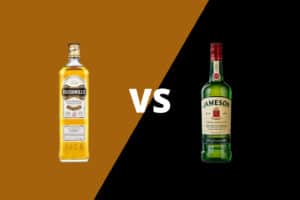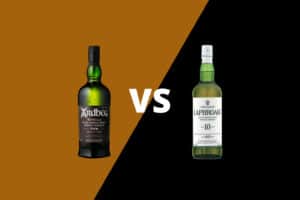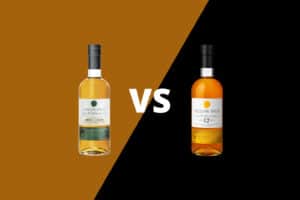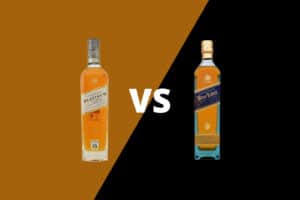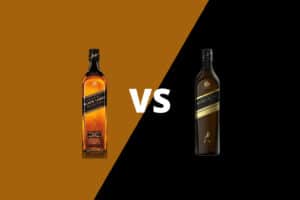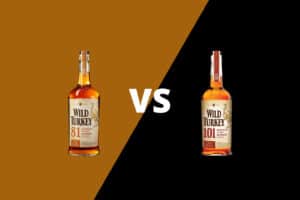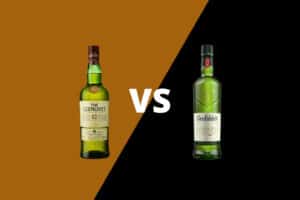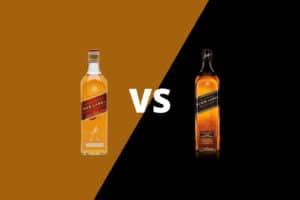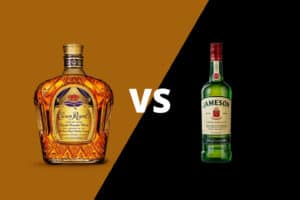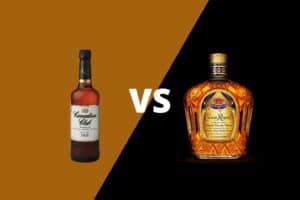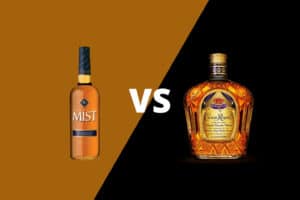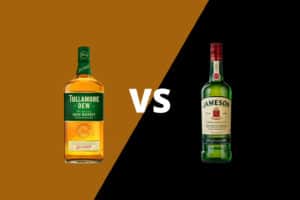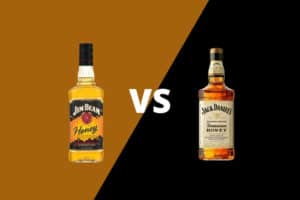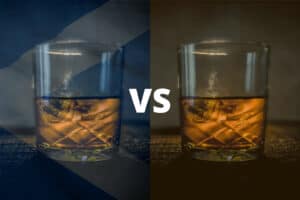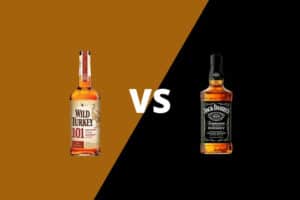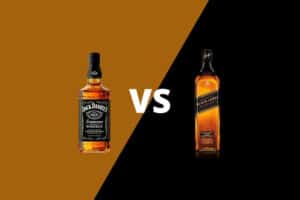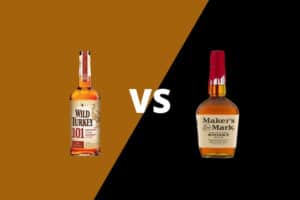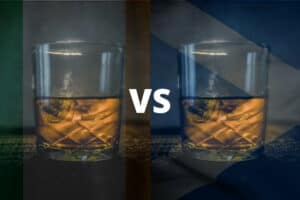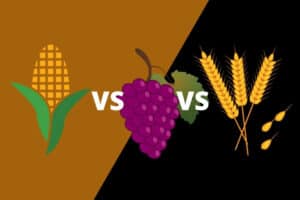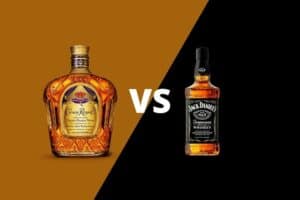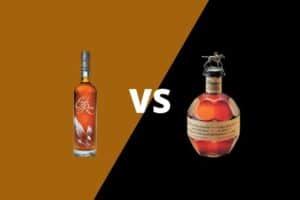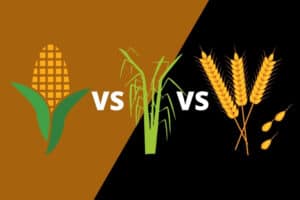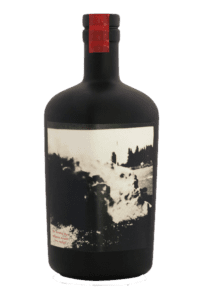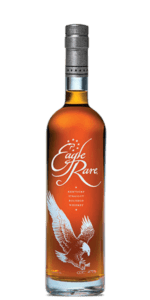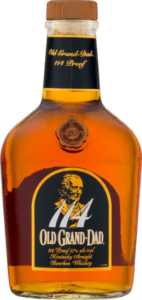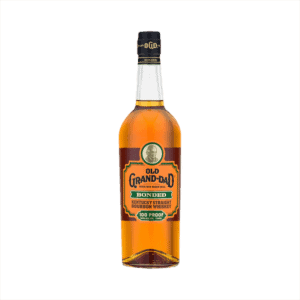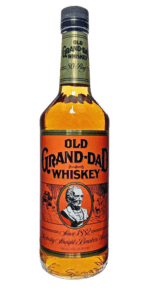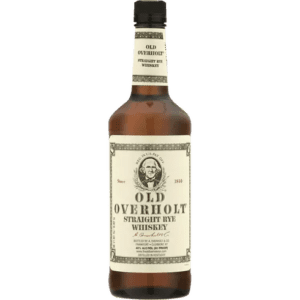Let’s go back to the basics. The very basics.
What is whiskey? Is it whiskey or whisky? And is it liquor or spirits?
Don’t worry, we’ll answer this and more. In the beginning, learning about distilled spirits can be like drinking from a fire hose. But in this post, we’ll pump the brakes so you can learn the very basics about what whiskey is, how it is made and where it comes from.
We’ll help you correctly identify the difference between Jack Daniel’s and Johnnie Walker and help you understand how they are related — as well as the vast differences between them.
But be careful.
Many a whiskey fanatic started by chipping off that very tip of the proverbial iceberg. So keep reading, and — next thing you know — you might find yourself down the rabbit hole as a full-on whiskey nerd!
Table of Contents
What’s the Difference Between Whiskey and Whisky?
There’s a couple of factors at play here. First, people in the United Kingdom have a funny way of spelling things differently: color vs. colour, specialization vs. specialization, theater vs. theatre and whiskey vs. whisky. Part of this comes from the regional variation in spelling and grammar.
Americans spell it ‘whiskey,’ while commonwealth countries England, Scotland, Canada and Australia spell it ‘whisky.’ But the Irish also spell whiskey with an ‘e,’ and they are usually quite fond of the Oxford Dictionary. So, what gives?
Well, the Irish and the Scottish counterparts came up on different sides of an early 19th-century dispute over whether spirits produced in the newly-invented ‘Coffey’ column still could be called ‘whisky.’ Before then, both spellings were used more-or-less interchangeably. But when the invention won the day, Irish distillers uniformly added they ‘e’ out of protest — or so the story goes.
Today, American and Irish whiskeys continue to use the ‘e’ when spelling whiskey.
What Defines Whiskey as Whiskey?
It depends on where you live. Let’s check out some specific rules in some of the biggest producing countries.
Many whiskey-producing countries have rules that reflect their unique history. American rye whiskey and bourbon are produced in the United States under the purview of domestic regulations. Scotch is made in Scotland according to United Kingdom law. And Canadian whisky is made in Canada under rules governed by Ottawa. Ditto for Japan.
These nations, along with the European Union and countries like Mexico, all have reciprocal agreements: e.g., We won’t let anything made outside Mexico call itself ‘tequila’ if you do the same for any products labeled bourbon.
What is Whiskey Made of?
Each of the examples above is a specific kind of whiskey. And while each of these countries has specific rules governing particular sub-categories, they generally agree that whiskey must be made from 100 percent grains and matured in a wooden cask for a period of time to mature.
Where it gets tricky is the odd non-traditional whiskey nation. A great example is India — one of the top scotch-consuming markets in the world. In India, it is okay to use non-grain ingredients in a whiskey mash, and many producers use things like corn syrup or sugar to increase yields during fermentation. Disagreements have emerged between the governments of the United Kingdom and India as a result.
How is Whiskey Made?
Let’s go through this step-by-step.
Mashing
To make whiskey, you must first produce an alcoholic beer. This beer has many similarities with your favorite craft brew. But the main difference is that it does not contain hops.
First, the whiskey maker must consider what grains they would like to use. Certain types of whiskey may have grain guidelines that must be followed — i.e., bourbon must contain at least 51 percent corn, single malt scotch must contain 100 percent malted barley, and Irish single pot whiskey must contain a blend of malted and unmalted barley.
The list of grain ingredients the distiller uses to create the whiskey is referred to as the mash bill because, in the next step, they will ‘mash’ and then ferment the grains. To create a mash, the whiskey maker grinds the grains and combines them with water. How fine the grain is ground is a variable that influences overall flavor. There are wet mills, cracker mills, roller mills, stone mills and hammer mills — all in varying sizes — which crush, cut/or pulverize the grain into a flour of varying fineness. The size of the flour influences how the enzymes and yeast get at the grain, ultimately affecting the congeners and acids produced during fermentation.
The ingredients are added with water into a large vessel to create a mash. In America, this vessel is called a mash cooker, and in Europe, it’s most often referred to as a mash tun. It is most often cylindrical in shape and will include an agitator to mix the ingredients, heating elements to cook the mash and cooling elements to bring the mash temperature back down.
Each whiskey maker has a specific recipe for each type of whiskey they make. In addition to the mash bill that defines the grain ingredients, the recipe includes how much water to add, cooking temperatures, yeast strains and quantities, any enzymes (if used) — kind of like baking a loaf of bread.
The mash is then heated to above 180 degrees Fahrenheit to induce a process called saccharification – a chemical reaction in which enzymes from malted grains break down the long-chain starch molecules into shorter glucose molecular chains that can then be digested by yeast during fermentation. To induce saccharification, the mash will be held at a high temperature for a period, and there may be several holds at various temperatures dependent on grains, enzymes, yeast varieties and other factors. Then, the mash is cooled to about 90 degrees Fahrenheit to produce a hospitable environment for the yeast.
Some whiskeys are distilled on the grains, and others are lautered to remove solids. For example, bourbon distillers in Kentucky traditionally mash on the grain, while European distillers in Scotland and Ireland traditionally lauter their mash to produce ‘wort.’
Fermentation
Next, yeast is introduced. Then, the mash or wort is pumped from the mash tun into a fermenter, where it will ferment for up to a week. In Europe, many historic distilleries use wooden or wood-lined fermentation vats, many of which are open fermenters — i.e., they have an open top. The wood in these vats hosts colonies of microorganisms, including lactobacillus and native, ambient yeast strains, that add complex flavors to the finished beer. Modern distilleries — including most of the large-scale production facilities in the United States — utilize stainless steel fermenters with closed tops.
Inside the fermenter, the yeast have a party, consuming sugar and expelling ethanol — the ethyl alcohol digestible to humans — and carbon dioxide. When they’re done, they have a terminal beer (in the United States) aka wash (in Europe) between six and 14 percent alcohol by volume (ABV).
Distillation
Next, this alcoholic liquid is pumped into a still to produce spirits. This process removes the alcohol and some flavor compounds, including congeners and esters, from the rest of the liquid by heating it to produce alcohol vapor and then condensing that steam back into a liquid with higher alcohol by volume than the original.
The choice of still makes a huge difference. A column still is a modern piece of equipment that uses plates to do nearly infinite distillations. A continuous column setup can pump beer into one end and finished spirit out the other, and the output can be fine-tuned to collect the desirable levels of alcohol and congeners. On the other hand, a pot still requires two distillations to get the alcohol up to strength, and many traditional types of whiskey utilize three passes in a copper pot still to produce refined flavors. Today, many modern craft outfits use hybrid stills that combine elements of pot and column stills to produce a variety of products.
[Learn more in our Distilling Alcohol 101 article.]
Maturation
The whiskey maker is left with a high-proof spirit called newmake, high wines or white dog after distillation. This clear, relatively neutral spirit is then pumped or poured into barrels where the interaction between wood, spirit, oxygen and time produce the color and flavor we’ve come to appreciate as whiskey.
Various types of wood and the duration in the cask will impart various flavors during the maturation process.
The most common type of wood used is oak. In the United States, new American charred oak barrels are required to produce bourbon, rye, Tennessee and other straight whiskeys. Used bourbon barrels are a favorite of the rest of the whiskey-making world. But European oak — including from northern Spain and France — are also utilized to produce unique flavors. The use of Mizunara oak from Asia was pioneered by Japanese whisky brands. And the use of casks previously used to age wines like port and sherry and other spirits like rum and tequila continue to evolve.
Whiskey Regulations
We mentioned previously ‘whiskey’ is a relative term — it all depends on where you live. Below, we’ll explore some of the different whiskey styles and categories you might see in your favorite whiskey shop and the terms to look for on the label — and what they mean. That way, you can make educated decisions on what to pour into your glass!
United Kingdom
Scotch whiskies are regulated by the United Kingdom. However, now that the nation has removed itself from the European Union, changes may further divide the two bodies.
Scotch must be made in Scotland and follow these rules:
- Scotch must be made from water, malted barley and other whole cereal grains. (The use of enzymes is not permitted in scotch production.)
- It must be distilled to 94.8 percent ABV or below.
- Fermentation and distillation must occur at the same location.
- Water and caramel coloring are the only allowed additives.
- Scotch must be aged in oak casks in Scotland at a licensed excise warehouse for at least three years in casks 700 liters or smaller.
Furthermore, there are several types of Scotch: single malt scotch whisky, single grain scotch whisky, blended malt scotch whisky, blended grain scotch whisky and blended scotch whisky. Each has its own production requirements. For example, single malt and single grain whiskies must be produced in a single distillery.
[Learn more in our Scotch vs. Whiskey article.]
Ireland
Irish whiskey must be produced on the island of Ireland — which is administered by the Republic of Ireland in the south and the UK-administered country of Northern Ireland. However, while this agreement has been one small focal point within Brexit negotiations, there have yet to be any changes to the shared UK-EU agreement on whiskey production rules.
Irish whiskey must be:
- Distilled in Ireland from a mash of cereal grains.
- Distilled to less than 94.8 percent alcohol by volume.
- Distilled so that the distillate retains the aroma and flavor of the materials used.
- Stored in wooden casks in Ireland for at least three years.
Like scotch, there are several sub-categories, each of which has its own rules: Irish grain whiskey, Irish single malt whiskey, Irish pot still whiskey and Irish blended whiskey.
[The post Irish Whiskey vs. Bourbon has much more information on these sub-categories.]
United States
The United States has rules governing what can be called ‘whiskey’ and regulations for specific types of whiskey, including bourbon, American rye whiskey, and Tennessee whiskey.
In the U.S., ‘Whiskey’ must be distilled from a fermented mash of grain at less than 190-proof (95 percent ABV) and bottled at no less than 80-proof (40 percent ABV).
We’ll explore some sub-categories briefly. In addition to those listed below, there are additional whiskey types in the U.S., including corn whiskey and straight malt whiskey.
Bourbon Whiskey
Bourbon can be produced anywhere in the United States, but in practice, more than 90 percent of bourbon is made in Kentucky. Bourbon:
- Must be made with at least 51 percent corn.
- Must be distilled to no more than 160-proof.
- Stored in a new charred oak barrel at a maximum 125-proof.
- Bottled at no less than 80-proof.
[For more information about bourbon, check out this post about ‘Wheated’ Bourbon breaks down bourbon mash bills pretty well.]
Tennessee Whiskey
The most well-known example of Tennessee whiskey is Jack Daniel’s — the No. 1 selling American whiskey both domestically and internationally. Tennessee whiskey follows all the rules of bourbon, with these additional qualifiers:
- Must be distilled, aged and bottled in the state of Tennessee.
- Must use a maple charcoal filtering process known as the ‘Lincoln County Process.’
[For more information about Tennessee whiskey, check out this review of Jack Daniel’s.]
Rye Whiskey
In the United States, a product must contain 51 percent rye grain and adhere to standards similar to bourbon. But we identify this as American rye whiskey to differentiate from Canadian whisky, which allows a product with any proportion of rye grain to be called ‘rye’ on the label. This can be confusing because reciprocity between the two countries means two drastically different products could sit on the shelf next to each other with similar language on the label.
[This post about Old Overholt has a lot of information about rye whiskey.]
European Union
Now that Britain has divorced itself from the EU, whisky fans anxiously await to see whether the United Kingdom changes its standards. Of course, the EU and UK align on these standards for now, but any changes by the UK might not only affect scotch whiskey but may create a rift between the Republic of Ireland — still an EU member — and Northern Ireland, which is a part of the United Kingdom.
To be labeled as whiskey in the EU, the contents of the bottle must adhere to the following:
- Produced by distilling a grain mash made from malted cereals. It may contain unmalted grains.
- Distilled to less than 94.8 alcohol content to reflect the flavors of the raw materials.
- Aged in wooden casks no larger than 700 liters for at least three years.
- Bottled at a minimum 40 percent ABV.
Canada
Canadian whisky is a blend between two worlds — the old world approach of Scotland and the influence of rye grain common in North American whiskey making. To be considered a Canadian whisky, a product must:
- Be made from a mash of fermented cereal grains.
- Be aged in ‘small’ wooden containers for at least three years.
- Have the character associated with ‘Canadian whisky.’
- Be mashed, distilled and matured in Canada.
- Bottled at 40 percent ABV or higher.
Japan
Japanese whisky shares a common history with scotch, as Masataka Taketsuru — often considered the godfather of Japanese whiskey — studied in Scotland’s historic single malt distilleries during the early 20th century. His passion for whisky laid the foundation for some of the best whiskies in the world today.
The rules governing Japanese whisky are lax compared to North American and European whiskey nations. However, in February 2021, the Japan Spirits & Liqueurs Makers Association released official standards for labeling, which has called for voluntary labeling standards. The two most prominent players, Suntory and Nikka, have agreed to the measures. Each has about a century of history making whiskey and distilled spirits on the islands.
Up-and-Coming Nations
Australia, New Zealand, India and Taiwan are also making contributions to the whiskey world, and distillation on mainland China has also begun in the past decade or so.
FAQs
You’ve got questions. We’ve got answers.
The only ‘stupid’ question is the one unasked, so let’s run through some concepts that may trip up beginners. If you’re new to this whiskey scene, no worries — we all were there at one time. Once you hit age and majority and walk into your first whiskey bar, it can be pretty overwhelming. Good on you for doing some homework!
Check through these frequently asked questions and confidently order yourself a dram — aka a Scots term for a glass of whiskey. And here’s a tip: Hydration is important! So, ask for a glass of water to go with your whiskey.
What is the difference between whiskey and other spirits?
Whiskey is made from grains. You make beer first, then you distill it into whiskey. Other spirits are made from other alcoholic ferments. For example, brandy and cognac are made from wine and tequila is made from an agave ferment similar to the traditional drink found in Central America.
What is the difference between bourbon and whiskey?
All bourbons are whiskey, but not all whiskeys are bourbon. Funny, we actually cover that in our [Bourbon vs. Whiskey] post.
How to drink whiskey
Answer: Any damn way you please. [Check out our article How to Order Whiskey Like a Gentlemen] to learn more.
Why you can add water to whiskey
A bit of high-quality mineral water actually ‘opens up’ the whiskey. Many industry professionals do this when compiling tasting notes because aromas and flavors become more apparent to the nose and palate at lower proof. This is especially true of high-proof and barrel-proof bourbons and whiskey. Many old timers who prefer their whiskey this way hark back to a time before Prohibition when barreled in bond bourbons were king of the market.
What is the difference between Irish Whiskey and Scotch?
We covered this one too: [Irish whiskey vs. Scotch]
What is the difference between scotch and bourbon?
Same. Check out: [Scotch vs. Bourbon]













